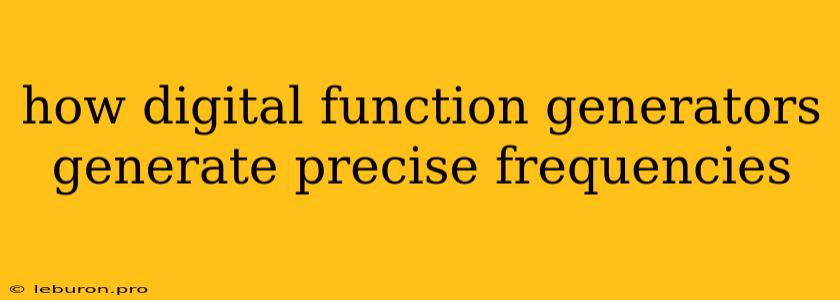Digital function generators are essential tools in electronics, playing a crucial role in testing and designing circuits. Their ability to generate precise frequencies is a fundamental feature that makes them invaluable for various applications. Unlike their analog counterparts, digital function generators leverage the power of digital signal processing (DSP) to achieve remarkable accuracy and versatility. This article delves into the inner workings of digital function generators, unraveling the mechanisms by which they produce precise frequencies, exploring the benefits they offer, and highlighting their applications in the realm of electronics.
The Essence of Digital Function Generators
At their core, digital function generators are electronic instruments that produce various waveforms, including sine, square, triangle, and sawtooth, with a high degree of control over their frequency, amplitude, and duty cycle. These generators find applications in a wide array of scenarios, ranging from testing the behavior of amplifiers and filters to simulating real-world signals in communication systems.
From Digital to Analog: The Conversion Process
The key to understanding how digital function generators generate precise frequencies lies in their underlying architecture. Unlike analog function generators, which rely on analog circuits to produce waveforms, digital function generators employ a combination of digital signal processing and digital-to-analog conversion (DAC).
- Digital Signal Generation: The process begins with a digital signal representing the desired waveform. This digital signal is generated within the generator's internal memory or processor, where it is defined as a series of discrete values.
- Digital-to-Analog Conversion: The digital signal is then fed into a digital-to-analog converter (DAC). The DAC transforms the digital values into an analog voltage or current, effectively converting the digital signal into an analog waveform.
- Waveform Shaping: Depending on the desired output waveform, the analog signal undergoes further processing to shape its characteristics. For instance, a sine wave might be generated by applying a digital approximation of a sine function to the DAC.
Achieving Precise Frequencies
The precision of frequency generation in digital function generators stems from the inherent accuracy of digital signal processing. Here's how it works:
- Frequency Control: Digital function generators typically use a digital counter to generate a specific frequency. The counter increments at a constant rate, and its output is used to determine the rate at which the DAC produces samples for the waveform.
- Precise Timing: The counter's operation is based on a precise timing reference, often derived from a crystal oscillator or a high-performance clock source. This ensures that the frequency generated is highly accurate and stable.
- Frequency Resolution: Digital function generators offer excellent frequency resolution, allowing users to fine-tune the output frequency with great precision. The resolution is directly related to the number of bits in the counter and the speed of the clock source.
Benefits of Digital Function Generators
Digital function generators offer several distinct advantages over their analog counterparts:
- High Accuracy and Stability: The reliance on digital signal processing and precise timing sources ensures high frequency accuracy and stability, reducing the potential for drift or errors.
- Flexibility and Versatility: Digital function generators provide a high degree of flexibility in terms of waveform generation. They can produce a wide variety of waveforms, including complex signals that are difficult to generate using analog methods.
- Programmability: Many digital function generators are programmable, allowing users to define and store various waveforms, frequencies, and other parameters. This makes them ideal for automated testing and repetitive tasks.
- Enhanced Functionality: Digital function generators often offer additional features such as sweep functions, burst mode operation, and advanced triggering capabilities, expanding their usefulness in a wide range of applications.
Applications of Digital Function Generators
The precise frequency generation capabilities of digital function generators make them indispensable in a wide array of fields, including:
- Electronics Testing and Design: Digital function generators are widely used for testing the performance of amplifiers, filters, and other electronic circuits. They can provide precise signals to analyze circuit responses and identify potential problems.
- Communication System Simulation: Digital function generators are invaluable for simulating real-world signals in communication systems. This allows engineers to test and optimize the performance of communication devices in realistic scenarios.
- Education and Training: Digital function generators are essential tools for electronics education and training. They allow students to gain hands-on experience with various waveforms and signal processing concepts.
- Research and Development: Digital function generators play a crucial role in research and development, particularly in areas related to signal processing, control systems, and advanced electronics.
Conclusion
Digital function generators represent a significant advancement in the realm of electronics, providing unparalleled accuracy, flexibility, and control over frequency generation. Their ability to produce precise frequencies stems from their underlying architecture, which leverages the power of digital signal processing and digital-to-analog conversion. The benefits they offer in terms of accuracy, stability, programmability, and functionality make them indispensable tools for testing, designing, simulating, and analyzing electronic circuits. As electronics continue to evolve, the role of digital function generators is likely to become even more prominent, fueling innovation and driving advancements in the field.
